Key takeaways:
- Storytelling is essential in funding pitches; a compelling narrative connects the entrepreneur’s passion to profitability.
- Thorough preparation and market research are crucial to avoid funding failures and articulate a clear vision that resonates with investors.
- Building relationships with investors before seeking funding can facilitate future opportunities and enhance credibility.
- Embracing feedback and adaptability strengthens proposals and fosters resilience in the face of setbacks.
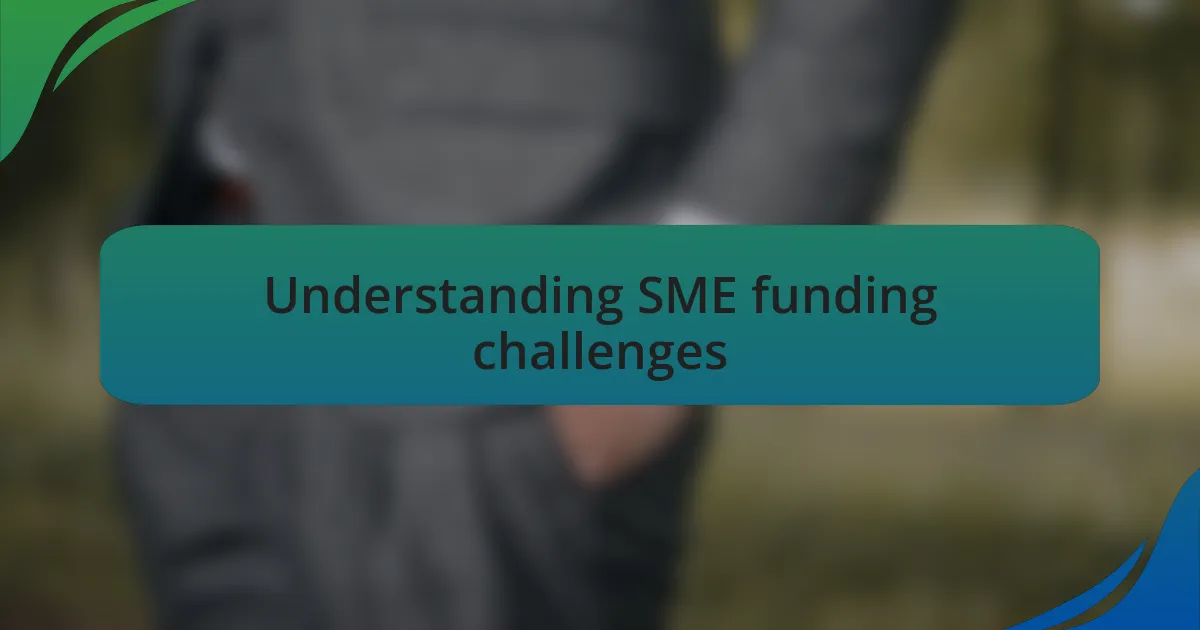
Understanding SME funding challenges
Navigating the funding landscape as an SME can be daunting. I remember sitting across the table from potential investors, feeling the weight of their expectations and concerns. It’s tough when you’re passionate about your business, yet face hurdles like limited access to capital or awkward lending terms. Have you ever found yourself trapped in that cycle of hope and disappointment?
One of the most frustrating aspects of funding challenges is the sheer volume of paperwork and preparation required. I’ve spent countless nights crafting business plans that felt more like essays than strategic documents. It often leaves you wondering, “Is my idea strong enough to overcome these barriers?” The reality is, many SMEs struggle to articulate their vision in a way that resonates with funders, which can lead to missed opportunities.
Moreover, market fluctuations can impact an SME’s attractiveness to investors. In my experience, when the economy takes a downturn, it feels like a door slamming shut right before you get to share your dreams. It’s disheartening, but understanding these cyclical trends can prepare you for the inevitable ups and downs, helping you craft a more robust funding strategy in the future.
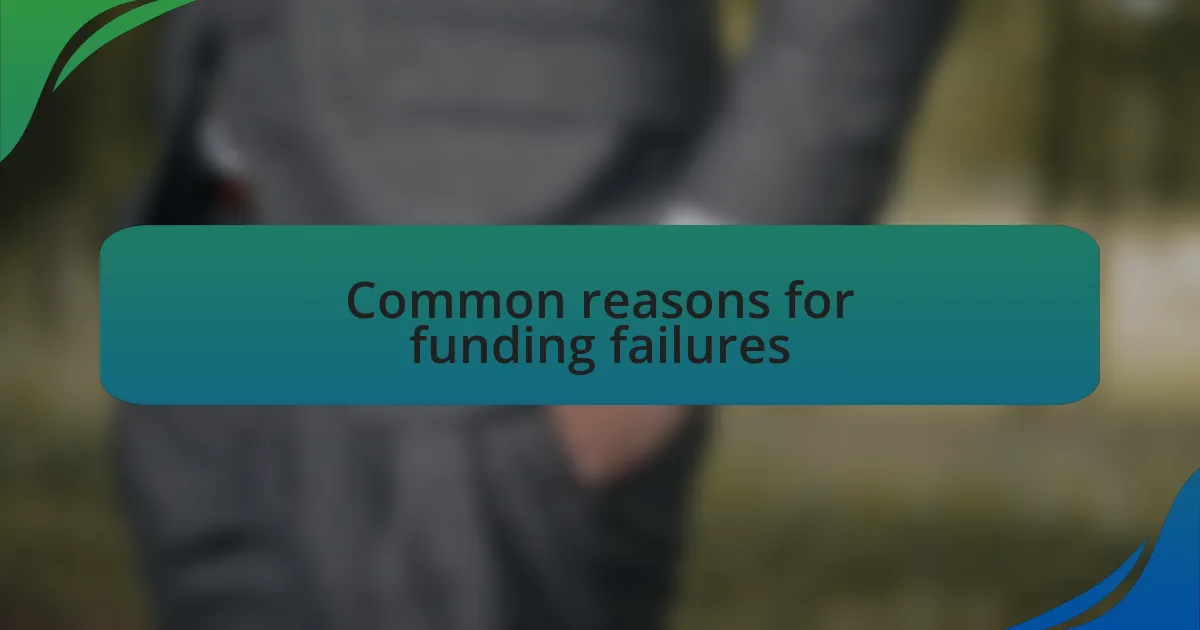
Common reasons for funding failures
Many funding failures stem from a lack of clear vision and strategy. I recall a time when I poured my heart and soul into a project without fully articulating its market fit. As a result, potential investors hesitated. They craved a compelling story that connected the dots between my passion and profitability. Have you ever felt that your enthusiasm wasn’t enough to bridge that gap?
Another significant reason is insufficient market research. I’ve learned the hard way that skipping this step can be disastrous. Early on, I assumed my idea would resonate universally, only to realize that understanding the target audience’s needs was crucial. It begs the question: how can you convince someone to invest if you don’t know who would buy your product?
Lastly, I’ve seen many SMEs falter due to unrealistic financial projections. I once presented numbers that I thought were optimistic but turned out to be overly ambitious. This not only disappointed potential funders but also caused me to lose credibility. How can we expect trust if we don’t present a feasible roadmap to success?
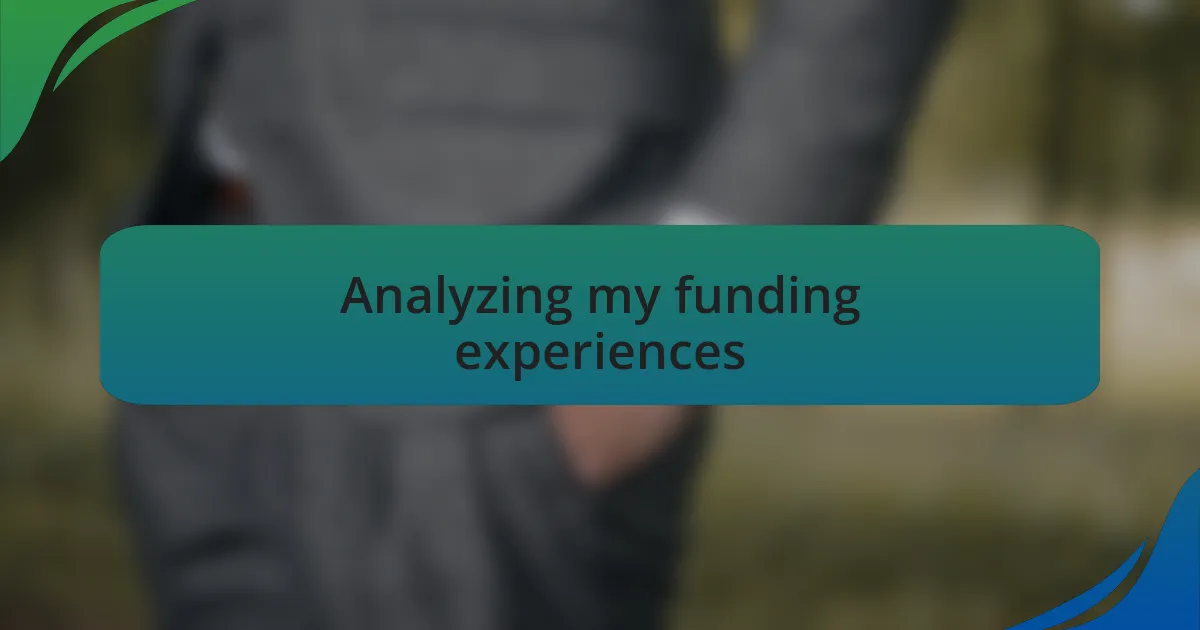
Analyzing my funding experiences
Reflecting on my funding experiences, I’ve come to realize that storytelling is at the heart of successful pitches. There was a time when I presented a project that felt incredibly personal to me, yet I neglected to weave a narrative that spoke to potential investors. Watching their blank expressions gave me an uncomfortable clarity: without a relatable story, even the most innovative ideas can fall flat. Have you ever tried to explain a passion project but felt the listeners disconnect?
Another lesson from my journey has been the critical importance of adaptability. I distinctly remember undergoing an intense pitch session where the feedback was overwhelmingly negative. At first, I was defensive, thinking my vision deserved to shine through as it was. It was a tough pill to swallow, but adapting my approach ultimately led to a better connection with my audience. Isn’t it interesting how our instincts can sometimes blind us to the very changes that would make our idea resonate?
Lastly, as I look back, I recognize how financial literacy plays a vital role in funding success. There was an occasion when my lack of understanding of cash flow management led me to misrepresent my financial health. Seeing the puzzled faces of potential investors as I struggled to explain my figures was humbling. It made me question: how can we ask for trust when we ourselves don’t grasp our own numbers? This has driven me to deepen my financial knowledge, turning past mistakes into stepping stones for future endeavors.

Key lessons from my failures
One of the most eye-opening lessons from my funding failures has been the necessity of thorough preparation. I recall a pitch meeting where I walked in underprepared, confident my charisma would carry the day. Instead, I faced tough questions that caught me off guard, leaving me flustered. It was a stark reminder that passion alone isn’t enough; robust preparation is essential. Have you ever found yourself in a similar situation, realizing that preparation truly builds confidence?
Another key takeaway has been the importance of seeking feedback early and often. In one instance, I became so attached to my original idea that I resisted input from my team. It wasn’t until I finally opened up to their suggestions that I uncovered valuable insights that transformed my concept. Listening to others isn’t just about humility; it’s about enhancing your work and building a stronger proposal together. Isn’t it fascinating how collaboration can spark creativity in ways we didn’t expect?
Finally, I’ve learned that resilience is crucial in the face of setbacks. There was a time when after a particularly rough rejection, I seriously considered giving up. But instead, I chose to analyze what went wrong and turn that pain into motivation. This experience taught me that a setback is often a setup for a comeback. Have you ever felt the weight of failure but found strength in pushing through? I certainly have, and it changed my approach to every challenge that followed.
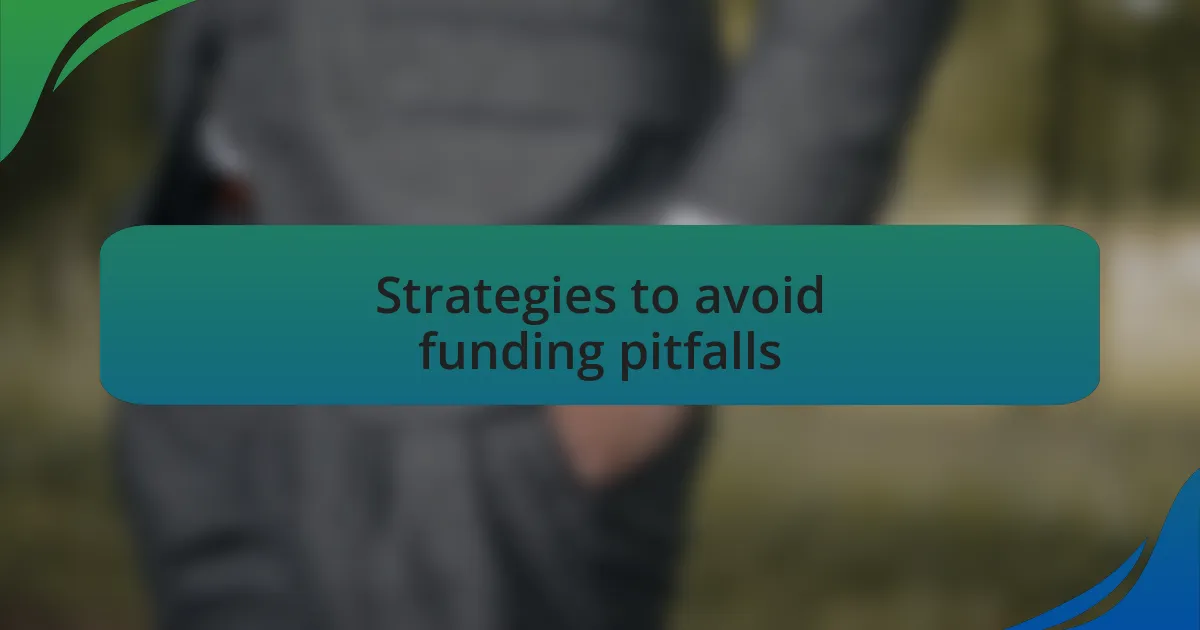
Strategies to avoid funding pitfalls
Navigating funding pitfalls has taught me the value of conducting comprehensive market research. There was a time when I plunged into a funding application without truly understanding my potential customers’ needs. The feedback I received was brutal but enlightening; I realized I’d crafted a solution to a problem that didn’t exist! How often do we assume we know what people want without asking them?
Another strategy I’ve adopted is to build relationships with investors before I actually need funding. I remember a networking event where I spoke with a potential investor about my passion project long before seeking their support. That seed of familiarity made it easier when I later approached them for funding. Isn’t it interesting how a simple conversation can lay the groundwork for future opportunities?
Lastly, maintaining clear financial records has been a game-changer for me. I had an experience where lack of organization led to confusion during a presentation to investors, ultimately costing me their support. Now, I prioritize transparency and accuracy in my financials, which not only boosts my credibility but also helps me identify areas for improvement. Have you ever wished you had a clearer picture of your financial health before going into a funding discussion? Trust me, it makes all the difference.
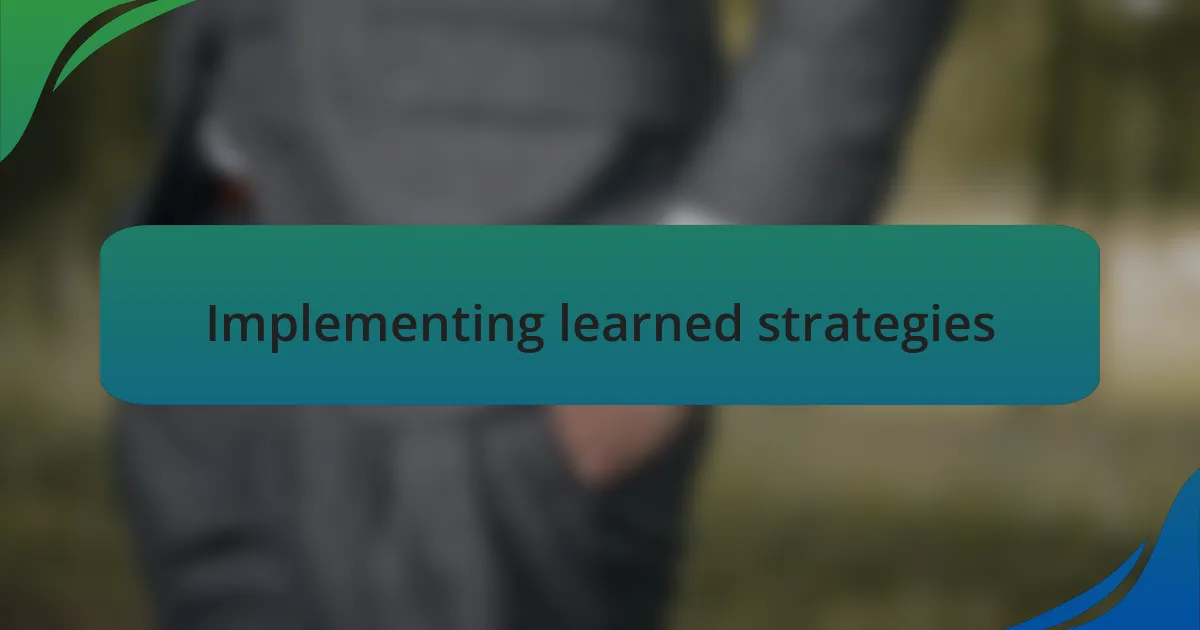
Implementing learned strategies
Implementing the strategies I learned from my funding failures has been a pivotal experience. One significant change was adopting a more iterative approach to product development. I vividly recall a project where I invested heavily into a finalized product before ever testing it in the real market. When I finally presented it, the lukewarm response from potential users hit hard. Now, I focus on piloting prototypes and gathering feedback early. This way, I ensure that I’m not only on the right path but also genuinely meeting the needs of my customers.
Another strategy that has proven effective is actively seeking mentorship from experienced founders. I remember sitting down with a mentor who candidly shared their own funding missteps, which opened my eyes to issues I hadn’t yet considered. The insights I gained were invaluable; they felt like a guiding light as I navigated my own challenges. I often wonder how many budding entrepreneurs miss out on such wisdom simply because they hesitate to reach out. It’s a reminder that asking for help can provide crucial support on the journey to securing funding.
Lastly, prioritizing storytelling in my pitches has transformed how I connect with potential investors. Initially, I approached funding discussions with a cold, data-heavy presentation. I soon recognized that investors want to feel inspired and understand the heart behind a business. I remember shifting from presenting dry statistics to sharing a narrative about my journey and the impact I aim to create. It not only captivated my audience but also fostered genuine connections. Have you ever considered how your story could resonate and drive interest? I’m convinced that our unique experiences can create compelling arguments for why we deserve funding.
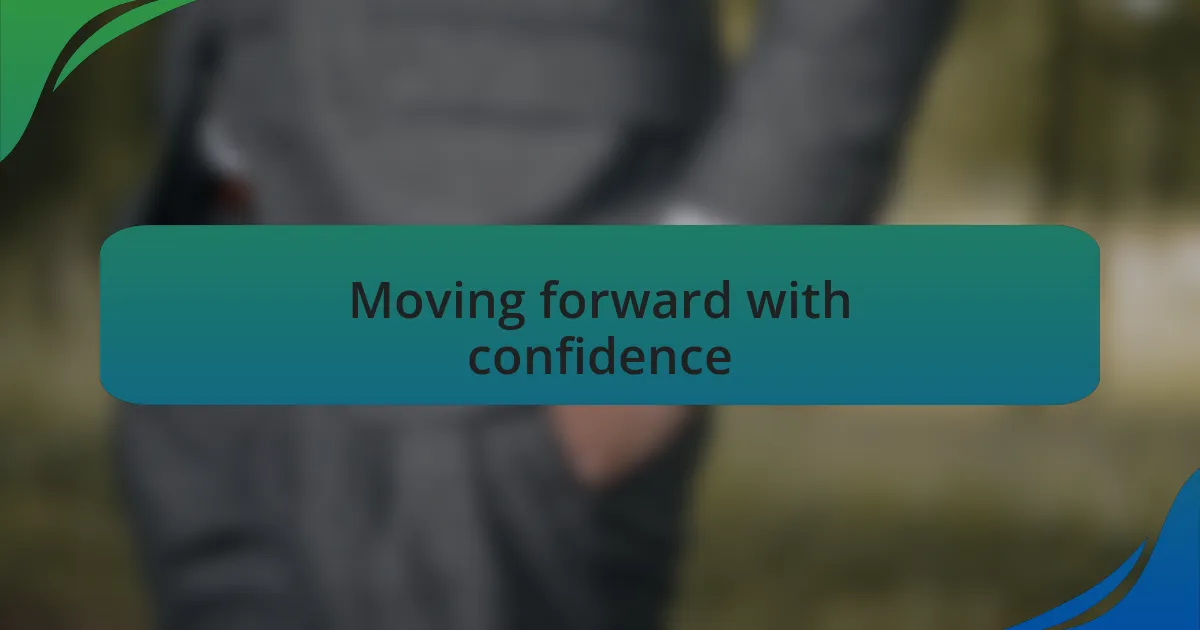
Moving forward with confidence
Moving forward with confidence means embracing the lessons learned from past funding failures. After my initial setbacks, I found myself reflecting deeply on the journey. I remember a moment of doubt when I thought, “Will I ever get it right?” But rather than wallowing in uncertainty, I chose to see my experiences as stepping stones. Each misstep became a piece of a puzzle that shaped my understanding of what truly resonates with investors and customers alike.
As I gained clarity, I realized that confidence isn’t just about having perfect plans—it’s also about the resilience to adapt. I often think of a time when I pivoted my business model entirely, driven by feedback I received after a failed pitch. It felt daunting, but addressing those concerns head-on filled me with a renewed sense of purpose. Have you ever felt that rush of determination when you make a choice aligned with your vision? Embracing change has empowered me to tackle new challenges.
Additionally, I’ve learned that sharing my journey openly with others cultivates a supportive network, reinforcing my confidence. I recall sharing my failures during a local entrepreneurship meetup, where others related to my struggles. That sense of camaraderie is invaluable. It became clear to me that being vulnerable fosters connections and inspires courage. Isn’t that a reminder that we’re all in this together, learning from our triumphs and failures? This shared experience builds not just confidence but a community nurtured by resilience.